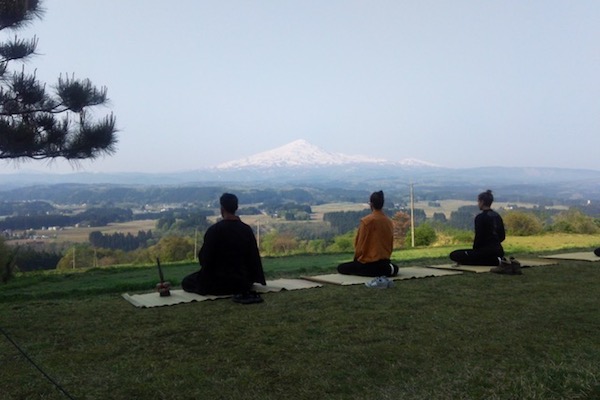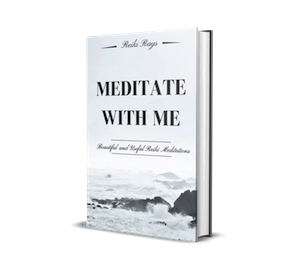Article by Nathalie Jaspar
When I started my Reiki journey 13 years ago, I had no clue this spiritual practice had its roots in Japanese esoteric Buddhism. As I advanced in my practice, I discovered teachers that had gone to Japan and brought back an approach that incorporated meditations and chanting on top of the hands-on healing techniques for which Reiki is mainly known today.
When I started teaching more and more Reiki classes, I felt the need to travel to Japan to experience these teachings directly. I am a very minimalistic person and a bit of scaredy-cat, so I decided to enter a Zen Buddhist meditation hall for three weeks instead of experimenting with the more esoteric practices from the Tendai and Shugendo side (meditating in cold waterfalls, hiking mountains for hours chanting mantras, etc.)
I wanted a non-touristy place with serious teachings. After loads of research, I found a place in the middle of nowhere Japan called Chokai-san International Zendo. It offered training in Zazen (sitting meditation) and Zen Buddhism in English and Japanese, meals, and no wifi. It was located in Yashima, a town so remote, the Japanese Rail customer service could not find it in their computer system.
When I got to Yashima, I was received with a warm, heart-filled smile from the Zendo’s Abbot, who was wearing a plain monk’s work outfit. His modesty was terrific: he didn’t want to be called Joko-Roshi or sensei, just plain Joko (we settled on Joko-san.) He took us to a beautiful location in the middle of the mountains in which, during the next few weeks, he taught me many lessons through his words, but mostly his actions.

Here are three lessons that changed my practice:
1. Don’t sit for yourself, sit for every living being
Most of us meditate for a purpose: stress reduction, a desire for clarity, happiness. For Zen monks, centering the practice on your wellbeing and setting an expectation of improvement are some of the most significant barriers to deepening your practice, although they may work as great motivators in the beginning.
The more we expect from meditating, the more we measure, label, and compare our so-called progress, the less compassionate we are with ourselves. Joko-san kept telling me: “Don’t try so hard, just sit to enjoy the fact that you are breathing, that you are alive and are part of everything alive.” According to him, an attachment to self-healing makes the practitioner more unstable and frustrated, instead of more accepting and relaxed. Moreover, I have to say that this tweak in approach has made my meditation way more approachable and enjoyable.
2. Keep your posture straight and stable, soften your heart and mind
Joko-san was very humble and relaxed, but when it came to the ritual of sitting in Zazen, he was firm. No socks, half or full lotus, knees on the floor, spine straight and chin tucked in. No slacking, no scratching, no moving even when mosquitoes harassed you. During our evening chats, he would explain that Japanese Zen practices may seem rigid. For them, however, having a disciplined ritual was an anchor that allowed them to let go and open their minds. “Nathalie-san, we have firm rituals, soft, open minds. Other people seem less rigid because their rituals are more relaxed and loose, but their minds are closed and hard.” Although as a Scorpio, I have a rebellious streak in me, I stuck to the ritual. After three weeks, I could see that the rigidity and simplicity of the Zen practice is indeed an illusion that hides many layers of depth.
3. Keep your eyes open
I always meditated with my eyes closed. It made it easier to quiet my mind, connect with my body and the sensations within it. However, it also meant these sensations—sometimes quite powerful or entertaining—acted as distractions. On top of that, it made it hard to translate the benefits of meditation to everyday life.
Meditating with our eyes slightly open is hard in the beginning, but, like every habit, once you do it for a few days, it becomes second nature.
I didn’t notice any profound shift while I was at the Zendo. It was hard not to be happy in such a peaceful place. Once back in New York, the change was startling. Anytime there is a crowd, a rush, or lots of noise, all factors that tend to trigger stress-responses in my system, I would go reflexively into Zazen breathing and feel that soothing spaciousness. Keeping my eyes open also makes it easier to track my mind: if I am not looking at the floor, I know it wandered away!
These lessons not only allowed me to go deeper into my Reiki meditation practice (Zazen is similar in a way to Joshin Kokyu Ho), but these shifts in mindset have added a beautiful stillness and focus to my sessions. What do you do to go deeper into your Reiki practice?
The Chokai-san International Zendo welcomes any person who wishes to share the practices of a traditional Zen temple, including meditation (Zazen), sutra chanting, formal temple meals, and daily work.
Free eBook download: We’ve created an eBook with our best articles on this topic, and offer it for free to all our newsletter subscribers.


Nathalie Jaspar
Nathalie Jaspar is a Reiki master with over 15 years of practice. Her mission is to deepen the understanding of Reiki practice in the world. She is a graduate teacher from the International House of Reiki, also trained with the Center for True Health, and the International Center for Reiki. To gain an even deeper understanding of Reiki practice, Nathalie went to Japan to practice Zen Buddhism at the Chokai-san International Zendo. Nathalie is the author of Reiki as a Spiritual Practice: an Illustrated Guide, and the Reiki Healing Handbook. She is the host of the Dive Into Reiki podcast and has been invited to demonstrate Reiki practice at venues such as Soho House, the New York Jet’s Athletic Center, and Fashion Week.
You can reach her via www.diveintoreiki.com, or https://www.facebook.com/Dive-Into-Reiki/





Thank you for sharing your experiences and the new opportunities they brought, not only to you, but inspiring everyone else too! 🙂 Namaste…
Thank you very much EL!
What a beautiful experience you had Nathalie. Though I know reiki is from Japan, I failed to understand my curiosity about Japan. This story of yours beamed a light upon it. I also practice reiki with open eyes as I tend to fall asleep.
Thank you Naveeta. Hope you can make it there one day. 🙏🤗
It’s essential for every man
Thank you for sharing that wonderful experience! I find people try too hard and grow impatient if they dont immediately get the results they wanted.
I try to just enjoy the moment and imagine Shamanic drums which takes me into a deeper meditative state.